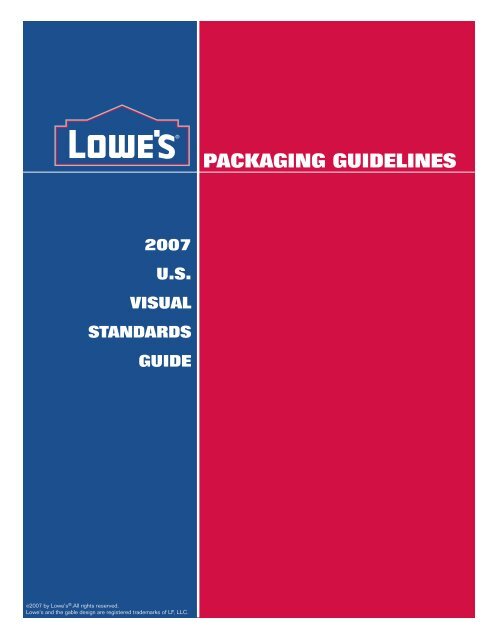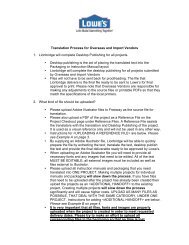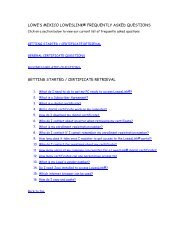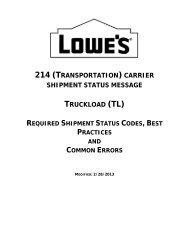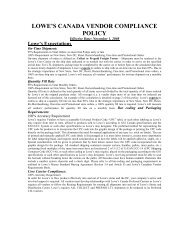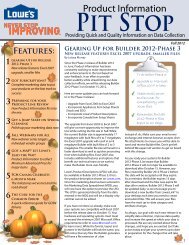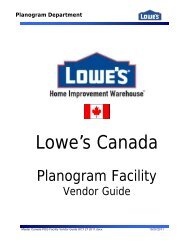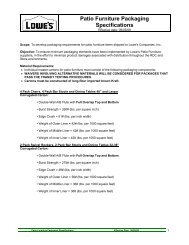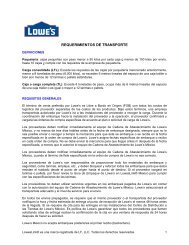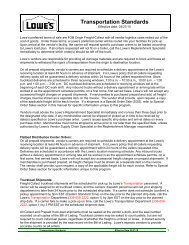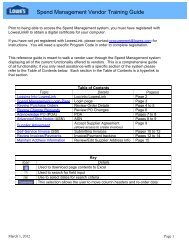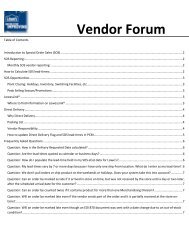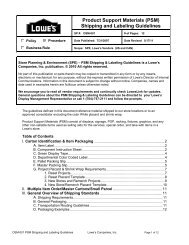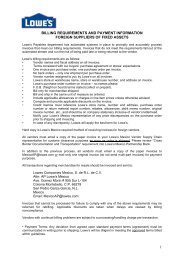PACKAGING GUIDELINES - LowesLink
PACKAGING GUIDELINES - LowesLink
PACKAGING GUIDELINES - LowesLink
Create successful ePaper yourself
Turn your PDF publications into a flip-book with our unique Google optimized e-Paper software.
<strong>PACKAGING</strong> <strong>GUIDELINES</strong><br />
2007<br />
U.S.<br />
VISUAL<br />
STANDARDS<br />
GUIDE<br />
©2007 by Lowe's ® .All rights reserved.<br />
Lowe's and the gable design are registered trademarks of LF, LLC.
114<br />
Packaging Guidelines Lowe’s 2007<br />
Packaging | Packaging Policy<br />
All packaging materials must be best-of-class in order to fulfill our Corporate mission statement.<br />
A warehouse environment makes packaging more, not less, important. The following provides guidance on packaging standards.<br />
Vendors are encouraged to discuss packaging plans during the line review process.<br />
Packaging Considerations<br />
Overall design<br />
Communication<br />
HIERARCHY<br />
Feature/Benefit Copy<br />
Language<br />
Photography<br />
Font<br />
Should be appropriate to Good/Better/Best level (e.g.: good level should not look more premium<br />
than better or best). Should be consistent across the brand and product lines (e.g.: logo,<br />
color coding, visual architecture, etc.). Brand logo and product description should be on all<br />
panels. Product must be identifiable regardless of the orientation (side) of the box.<br />
Logo, product descriptor, series/collection name, feature/benefit copy, photography should<br />
be appropriately sized in relation to other communication according to consumer decision<br />
process. Components should not visually compete, but work in concert.<br />
Short and to the point. Any feature mentioned should also communicate benefit (e.g.: powdercoated<br />
finish for durability). Copy points should be kept to the most important (target three to<br />
five points). Should include points of differentiation.<br />
As much as possible, use artwork, icons, or photography to call out features and benefits.<br />
To the extent that text is used, Spanish translations are required for all text on all packaging<br />
to be shipped and distributed as of 9/1/05 within Lowe’s stores in the US. French Canadian<br />
translations and compliance with all Canadian Packaging Laws are required for all packaging<br />
to be shipped in 2007 within Lowe’s stores in Canada. Achieving these two objectives can<br />
be achieved by either preferably producing trilingual packaging, or alternatively producing two<br />
bilingual packages. (See page 128 for more details.) Vendors who wish to be considered<br />
for distribution in Canada should begin the process now to secure translations and to layout<br />
packaging. Please check Loweslink.com regularly for more information on our<br />
expectations of vendors to support our launch into Canada.<br />
Should have appropriate style/content (e.g.: lifestyle, product use, etc.). Product shot should<br />
be the hero. See Content Management Guidelines for more details and requirements.<br />
Must be legible (remember the population is aging). Style should support brand position.<br />
When possible: Lowe’s item number should appear in the upper right-hand corner of each<br />
side of the master carton package in a san serif font, black ink, 1 inch high font size.<br />
Master carton quantity should appear with the item number before the actual quantity.<br />
Warnings/PRODUCT<br />
CERTIFICATIONS/<br />
Installation<br />
Warranty/ Assembly<br />
Must follow legal requirements.<br />
Warranty information is a purchase consideration in many categories and should be<br />
called out with appropriate hierarchy. List tools needed for assembly or the fact they<br />
are included.<br />
Variables Affecting Packaging Considerations<br />
• Specific product category and specific product<br />
• Box/Package Size/Configuration<br />
• Importance of brand vs. other elements (e.g.: Is it an alliance partner and the brand logo needs to be dominant?)<br />
• Legal issues<br />
.
115<br />
Packaging Guidelines Lowe’s 2007<br />
Packaging | Packaging Policy<br />
Lowe’s Packaging Mandatories<br />
Logo<br />
Product Descriptor<br />
Country of Origin<br />
Distributor Information<br />
Model Number<br />
Measurement Indicators<br />
UPC Code<br />
On all panels.<br />
On all panels.<br />
Must appear on side, top or back panel (not just bottom).<br />
Should be bold and the same point size if not larger than distributor<br />
copy.<br />
Must include name, address, country of origin.<br />
Located with distributor information.<br />
Do not use symbols vs. words for product description measurements,<br />
weights, etc. (ex.: use “in.” or “inches” versus using "). Convert measurements<br />
to metrics to meet the requirements of the Fair Packaging and<br />
Labeling Act (FPLA).<br />
The preferred method for representing the UPC code for your product is<br />
to incorporate the UPC code into the graphic design for the package or<br />
printing the UPC code directly on the package itself. This eliminates the<br />
need for manual application of any type (i.e. stick on labels). The use of<br />
printed and manually applied UPC code labels is discouraged as it is more<br />
labor intensive, creates more opportunity for label tampering/fraud, and<br />
requires much consideration as to how the labels will be applied (adhesive,<br />
staple, location, etc.). Special consideration will be given to products<br />
that, by their nature, cannot have the UPC code incorporated into the<br />
graphic design for the package.
116<br />
Packaging Guidelines Lowe’s 2007<br />
Packaging | Proprietary and Non-Proprietary Brands<br />
Lowe’s Proprietary and Non-Proprietary Brand Packaging Review and Approval Process<br />
LOWE’S PROPRIETARY BRAND <strong>PACKAGING</strong><br />
Lowe’s has developed proprietary brands to fill gaps in our product assortment in areas where no strong national brands<br />
exist. These brands are an important part of the overall Lowe’s branding strategy. Lowe’s provides vendors with these<br />
proprietary brands to use on their products carried in Lowe’s stores. These brands are exclusive to Lowe’s.<br />
Brand standards are developed to guide and direct the appropriate use and application of the logo and name to help build<br />
and maintain a meaningful brand identity in consumers’ minds. Use of brand standards ensures consistent name and logo<br />
treatment of our proprietary brands in all consumer communications, from tabs to advertising.<br />
All Lowe’s proprietary packaging development should follow the Packaging Approval Process. Any updated proprietary<br />
brand standards should be executed on existing brand SKUs at the time of reprinting and reordering.<br />
No variations can be made to the information and directions contained in the brand standards without approval of<br />
the Packaging Project Manager, and Lowe’s Packaging Department must approve packaging mechanicals before final<br />
production.<br />
NON-PROPRIETARY BRAND <strong>PACKAGING</strong><br />
Lowe’s Packaging Department does not review packaging for non-proprietary brand products sold in-store. However, in<br />
order to comply with the Lowe’s Packaging Language policy, non-proprietary brand vendors are required to use a Lowe’s<br />
approved translation vendor. All brand vendors should keep their approval codes on file for auditing purposes.
117<br />
Packaging Guidelines Lowe’s 2007<br />
Packaging | Packaging Language Policy<br />
As of 9/1/05, all Lowe’s vendors are required to include English and Spanish translations on packaging<br />
distributed in Lowe’s US stores.<br />
In addition, any vendor wishing to be considered for distribution in Lowe’s Canadian stores in 2007 and<br />
beyond will be required to provide packaging in 2007 that is compliant with Canadian Packaging Laws.<br />
As a result, Lowe’s will require that all vendors either provide fully trilingual packaging OR that they maintain two different bilingual<br />
packages. It is the vendor’s decision as to how they can best meet Lowe’s objectives of providing the optimal<br />
packaging for distribution in all stores. Furthermore, it is the vendor’s responsibility to develop packaging<br />
that:<br />
• is consumer friendly;<br />
• is compliant with United States federal, state, and local laws;<br />
• is compliant with Canadian federal and provincial packaging laws;<br />
• and is compliant with Lowe’s Packaging Policies and Lowe’s language requirements as outlined in this “Visual<br />
Standards Guide: Packaging Guidelines” and the Master Standard Buying Agreement.<br />
These objectives can be achieved by either of the scenarios outlined below:<br />
Option 1: Trilingual Packaging<br />
• If trilingual packaging is produced, then the order of the languages must be English, French Canadian, and then Spanish.<br />
• All languages should have equal prominence.<br />
• Trilingual packaging must be compliant with all US local, state, and federal laws; Canadian federal and provincial<br />
packaging laws; Mexican NOM Standards; NAFTA; and Lowe’s packaging requirements.<br />
• Metric conversions must be included.<br />
OR<br />
Option 2: Two Fully Bilingual Packages<br />
• If two bilingual packages are produced, then one must include English and Spanish and one must be English and French<br />
Canadian.<br />
• The current packaging:<br />
• Will be distributed in the US;<br />
• Is required to be compliant with all US local, state, and federal laws and Lowe’s bilingual packaging<br />
requirements;<br />
• Should have the Spanish equally prominent as the English; however, under no circumstances can<br />
the Spanish be less than 50% of the size of the English and no less than 1/16th of an inch;<br />
• Requires metric conversions;<br />
• Is recommended to be compliant with all NAFTA standards and Mexican NOM standards (NOM<br />
standards requires Spanish equal in prominence to the English; see the section “Understanding<br />
Canadian, Mexican, and NAFTA Packaging Requirements” for more details.).<br />
• The English/French packaging:<br />
• Will be distributed in Canada;<br />
• Is required to have English and French Canadian;<br />
• Is required to be compliant with Canadian federal and provincial packaging Laws;<br />
• Must have the French at least equally prominent to the English;<br />
• Requires metric conversions;<br />
• Is recommended, but is not required, to follow Canadian English spelling and grammar rules.<br />
While trilingual packaging will definitely be preferred by Lowe’s, it is the vendor’s decision as to how<br />
they can best meet Lowe’s objectives of providing the optimal packaging for distribution in all stores.<br />
Furthermore, it is the vendor’s responsibility to develop packaging that is consumer friendly; compliant
118<br />
Packaging Guidelines Lowe’s 2007<br />
Packaging | Packaging Language Policy<br />
with Lowe’s Packaging Policies; compliant with US federal, state, and local laws; and compliant with<br />
Canadian federal and provincial laws.<br />
What happens if packaging is not compliant?<br />
Packaging will be audited periodically and inspected on a regular basis for adherence to all of Lowe’s requirements. Non-compliance<br />
by vendors with the packaging guidelines as outlined above, on pages 125-128 of this VSG manual, or the Master Standard Buying<br />
Agreement may result in the following:<br />
• product may be deemed defective<br />
• product may be subject to fines and/or removal from Lowe’s stores<br />
• product may be returned to the vendor at the vendor’s expense<br />
• shipments may be rejected<br />
• vendors may be delisted<br />
Vendors with product found to be non-compliant to US packaging requirements will be notified and will<br />
have 90 days to bring their product into compliance. These vendors will face fines, and their ongoing failure<br />
to comply with US requirements will make their product subject to removal from Lowe’s US stores.<br />
Vendors who attempt to ship their non-compliant product into Canada will have their shipments rejected<br />
and these vendors will face fines and delisting.
119<br />
Packaging Guidelines Lowe’s 2007<br />
Packaging | Packaging Language Policy<br />
Packaging Layouts with Additional Languages<br />
It is the vendor’s decision as to how to design their packaging so that they can best meet Lowe’s<br />
objectives of providing the optimal packaging for distribution in all stores. Furthermore, it is the<br />
vendor’s responsibility to develop packaging that is compliant with all applicable packaging laws.<br />
Vendors should work with their own packaging design companies to work through the details of how to accomplish<br />
bilingual or trilingual packaging design. Vendors are encouraged to work with companies that have experience in<br />
bilingual or trilingual design.<br />
For packaging inserts, any of the following layout options are recommended for bilingual (B) layouts or trilingual<br />
(T) layouts. (See the layout option illustrations and explanations in the “Visual Standards Guide: Translation<br />
Guidelines”):<br />
• Back-to-back - B<br />
• Back-to-back brochure - B<br />
• Consecutive - B or T<br />
• Flip over - B<br />
• Block-by-block - B or T<br />
• Horizontal block - B (or possibly T)<br />
• Fold out - B<br />
• Vertical columns- B (or possibly T)<br />
• Side-by-side panels (pages) - B<br />
Be certain to see the following sections in the Lowe’s “Translation Guidelines”:<br />
General Advice for Incorporating Additional Languages into Designs<br />
General Advice for Incorporating Additional Languages on Packaging
120<br />
Packaging Guidelines Lowe’s 2007<br />
Packaging | Packaging Language Policy<br />
Understanding Multilingual Packaging Requirements<br />
Canadian Packaging Laws<br />
Lowe’s has announced plans to expand operations into Canada in 2007. As a result, vendors who wish to be<br />
considered for distribution in Canada should begin planning now to secure translations and to layout packaging<br />
so they can potentially ship Canadian appropriate product to meet in-store dates for 2007 Canada stores. More<br />
detailed information will be provided at a later date through merchandising contacts regarding which vendors will be<br />
selected to distribute in Canada. Please check Loweslink.com regularly for more information on Lowe’s expectations<br />
of vendors to support our launch into Canada.<br />
In the meantime, please note that Canadian requirements respecting the packaging and labeling of pre-packaged<br />
products are set out in a number of federal and provincial statutes. The principal federal requirements are contained<br />
in the “Canadian Packaging and Labelling Act” and “Consumer Packaging and Labelling Regulations” and are<br />
summarized in the “Guide to the Consumer Packaging and Labelling Act and Regulations”. Copies of each of these<br />
documents are available online from the Canadian Competition Bureau’s website:<br />
http://www.competitionbureau.gc.ca/internet/index.cfm?itemID=148&lg=e#packaging<br />
Depending on the specific product and the province where it is sold, other federal and/or provincial legal requirements<br />
may apply in respect of the packaging and labeling of products in Canada. It is each vendor’s responsibility to be<br />
aware of and to ensure that its products comply with all applicable packaging and labeling requirements in those<br />
jurisdictions where Lowe’s carries on business.<br />
While the Canadian federal Consumer Packaging and Labelling Act and Regulations require only certain specific items<br />
to appear in both English and French, as a matter of Lowe’s company policy, Lowe’s will require that all of its products<br />
to be sold in Canada include translations into French for all product information as is required by the provincial laws<br />
of Quebec. For more information on the provincial requirements, please see the “Quebec Charter of the French<br />
Language: Title I : Status of the French Language; Chapter VII : The Language of Commerce and Business”:<br />
http://www.olf.gouv.qc.ca/english/charter/title1chapter7.html<br />
In particular, please see the “Requirements at a Glance: Products Offered in Quebec”:<br />
http://www.olf.gouv.qc.ca/english/infoguides/requirements/glance.html<br />
Mexican Packaging Laws<br />
The Trade Information Center of the US International Trade Administration (ITA) publishes several sources of<br />
information to help with understanding the requirements for product distributed in Mexico. In particular, Lowe’s<br />
recommends that vendors review and make every effort to comply with all applicable Normas Official Mexicana<br />
(NOMs) and the information as outlined in “Labeling Requirements Summary” which can be accessed as follows:<br />
http://web.ita.doc.gov/ticwebsite/naftaweb.nsf504ca249c786e20f85256284006da7ab06f14f6b7e28c2b0852<br />
5670400578312!OpenDocument<br />
Additionally, the ITA provides “Labeling Requirements: Overview and List of Documents” at the following website:<br />
http://web.ita.doc.gov/ticwebsite/naftaweb.nsf504ca249c786e20f85256284006da7ab27da1d64abb1681385<br />
2566bb0060c2c2!OpenDocument
121<br />
Packaging Guidelines Lowe’s 2007<br />
Packaging | Packaging Language Policy<br />
Understanding Multilingual Packaging Requirements<br />
For any additional questions, please contact: Trade Information Center 1-800-USA-TRADE<br />
For Unofficial English translations of Normas Official Mexicana (NOMs), please contact: National Law Center for<br />
Inter-American Free Trade at 800-529-3463, the Net Connection Corp. at 800-527-8779, or the National Institute of<br />
Standards and Technology (NIST), National Center for Standards and Certification Issues, at (301) 975-4040.<br />
NAFTA Standards<br />
Implemented on January 1, 1994, the North American Free Trade Agreement (NAFTA), is a comprehensive trade<br />
agreement that improves virtually all aspects of doing business within North America. NAFTA eliminates nearly all<br />
tariffs by 2008 between the U.S. and Mexico by 1998 between the U.S. and Canada, and removes many of the<br />
non-tariff barriers, such as import licenses, that have helped to exclude U.S. goods from the other two markets,<br />
especially Mexico.<br />
For more information on NAFTA Requirements in general, please access the following site:<br />
http://web.ita.doc.gov/ticwebsite/naftaweb.nsf<br />
For information on “Standards and Labeling” please see:<br />
http://www.mac.doc.gov/nafta/standards.html<br />
For any additional questions, please contact: Trade Information Center 1-800-USA-TRADE
122<br />
Packaging Guidelines Lowe’s 2007<br />
Packaging | Packaging Language Policy<br />
RECOMMENDED RESOURCES<br />
Metric Conversions<br />
Canadian Bilingual Packaging Standards<br />
Please consider reviewing the Canadian expectations in the area of metric conversions by reviewing the Canadian<br />
Bilingual Packaging Standards: http://strategis.ic.gc.ca/epic/internet/incb-bc.nsf/en/cp01007e.html<br />
Section 27 Regulations 2.2.6 Units (Metric Units of Measurement and Symbols) and Choice of Units (Type of Measure<br />
for Net Quantity of Product) Sections 25 & 26 Regulations 2.2.7 Precision of Number.<br />
Uniform Code Council<br />
www.uc-council.org<br />
GS-1 (formerly UCC/EAN)<br />
EAN International<br />
Brussels, Belgium<br />
32-0-2-227-10-20<br />
www.ean-int.org<br />
ISO - see previous page<br />
ANSI - see previous page<br />
California Standards of Measurement
123<br />
Packaging Guidelines Lowe’s 2007<br />
Packaging | Packaging Language Policy<br />
RECOMMENDED RESOURCES<br />
Periodic industry articles on packaging design topics where more than one language is used:<br />
www.packworld.com<br />
www.packagingdigest.com<br />
www.aiga.org<br />
Use of Universal Symbols<br />
Vendors are encouraged to carefully consider the use of universal icons on their packaging as a means of communicating;<br />
however, vendors must ensure that the icons used are in fact universally understood and that they make an impact. As<br />
a result, vendors are highly encouraged to first consider those symbols that have already been developed as universal<br />
standards as outlined by ISO and ANSI. Vendors should refrain from developing unique symbols for their products<br />
unless the symbols clearly communicate product features/benefits that are common across product groups; the symbols<br />
have been qualified and tested with consumers to prove that they communicate as intended and that the symbols could<br />
possibly be leveraged across multiple vendors and multiple product groups for consistency in packaging. For more<br />
information on universal symbols, please contact the following:<br />
International Organization for Standardization (ISO)<br />
Geneva, Switzerland<br />
41-22-749-03-36<br />
sales@iso.org<br />
ISO can provide information on International Graphical Symbols that might apply to the vendor’s business.<br />
American National Standards Institute (ANSI)<br />
212 642-4900<br />
info@ansi.org<br />
www.ansi.org<br />
ANSI can provide information regarding standards and universal symbols developed under the following policies that<br />
might apply to the vendor’s business:<br />
ANSI Z535, ANSI Z535.1, ANSI Z535.2, ANSI Z535.3, ANSI Z535.4, ANSI Z535.5, ANSI C95.2<br />
Hazard Communications Systems, LLC<br />
877 748-0244<br />
570 296-5686<br />
For International and US product safety symbols
124<br />
Packaging Guidelines Lowe’s 2007<br />
Packaging | Submitting Translations for Proprietary Brand Packaging<br />
Process for Submitting Translations for Proprietary Brand Packaging<br />
Proprietary Brand Packaging Product Vendors are required to follow the outlined process to be in compliance<br />
with Lowe’s Companies, Inc. bilingual and trilingual packaging initiatives.<br />
1. Obtain brand package standards for Proprietary Brand Packaging via e-mail link from Lowe’s Packaging Department.<br />
2. Create bilingual or trilingual brand package standards for proprietary brand packaging artwork using product<br />
information and follow the graphic format/ placement provided within the Brand Package Standards.<br />
3. Submit round one artwork (hard copies in color) to the Lowe’s Packaging Department using English placeholder<br />
copy for the translations. Numerous changes are made in the routing process, so wait for feedback before obtaining<br />
translations. This saves your company time and money.<br />
4. Changes are marked on color proofs during routing process internally at Lowe’s Companies, Inc.; proofs are then<br />
returned to vendor for updates.<br />
5. Update round one packaging proofs with feedback from Lowe’s Packaging Department, and submit to an approved<br />
Level One translation vendor for translations. If you already have packaging with translations from an unapproved<br />
translation vendor, please submit the packaging and translation for proofing by an approved Level One translation<br />
vendor. (For Level One translation vendors, visit www.loweslink.com.)<br />
6. Re-submit second round proofs to Lowe’s Companies, Inc. with translations correctly applied. Also, include e-mail<br />
confirmation of translation code* from approved translation vendor.<br />
7. Proofs re-route for final changes, etc.; this part of the process is repeated until proofs receive final sign off and are<br />
suitable to proceed to print.<br />
* Product Vendors are responsible for sending their approved translation code to Lowe’s Packaging<br />
Department. However, vendors must keep their codes on file as well. When packaging is audited<br />
by Lowe’s Companies, Inc., we may ask you to provide your translation code if any translations on<br />
your packaging are in question.
125<br />
Packaging Guidelines Lowe’s 2007<br />
Packaging | Submitting Translations for Instruction Manuals<br />
Process for Submitting Instruction Manuals for Approval<br />
PURPOSE<br />
The procedures outlined below detail the process in which Instruction Manuals are submitted for approval that are<br />
accompanying product that is carrying a Lowe’s proprietary brand.<br />
As a vendor partner of Lowe’s, your organization is using one of Lowe’s proprietary brands to package and distribute<br />
products in our stores. These Instruction Manual Standards will guide how you layout and print your instruction manuals.<br />
The LGS Technical Writing team must approve all instruction manuals carrying a Lowe’s proprietary brand before printing.<br />
We do not review instruction manuals that are not carrying a Lowe’s proprietary brand.<br />
The entire process from purchase to in-store is generally very accelerated and often, extremely time sensitive. For that<br />
reason, we have outlined specific procedures below to help expedite the process and avoid delays.<br />
INSTRUCTION MANUAL APPROVAL PROCESS<br />
Important Note: It is highly recommended that translations not be completed until after the English instruction manual<br />
has been approved by the LGS Technical Writer. If the instruction manual has already been translated by a third party<br />
(i.e. the vendor or a non-Lowe’s approved translation company), the instruction manual must still be sent to a Level 1<br />
Lowe’s Approved Translation Vendor for proofing.<br />
INSTRUCTION MANUAL APPROVAL PROCESS<br />
1. Create instructions manual(s) using the templates provided. Changes cannot be made to the format or layout<br />
contained in these templates without the approval of the Technical Writer. Samples of a short manual (less than<br />
10 pages) and a long manual (more than 10 pages) are included in the FileX package you will need to download<br />
from Lowe’s Brand Exchange. The instruction manual templates are contained as a separate zip file within each<br />
of the Brand Standards FileX downloads where you will also find packaging templates and guidelines.<br />
2. For first round manuals, please use English placeholder copy for the text to be translated into Canadian French<br />
and Latin American Spanish. Changes are typically made in the routing process, so wait for feedback before<br />
obtaining translations. This saves your company time and money.<br />
3. Submit Round 1 manuals (electronic .pdf file formats) and a completed New Project Submission Data Form to the<br />
Technical Writer mailbox (LGS.techwriter@lowes.com). The New Project Form is found in the FileX package.<br />
Instruction manuals should be named as follows:<br />
Item#_Item Desription_Vendor.pdf<br />
Example: 12345_Wire Shelving unit_XYZ Company.pdf<br />
New Project Submission Data Forms should be named as follows:<br />
Vendor_Data Form_date.pdf<br />
Example: XYZ Company_Data Form_01012006.pdf<br />
4. Upon receipt, manuals are logged in our tracking system and tracked from receipt to final approval.<br />
Please note the following important information regarding the submission process:<br />
• If all the manuals you are submitting total less than 5 MB, send them via email.<br />
• If all the manuals you are submitting total more than 5 MB, send them via mailing/shipping service* on a CD.<br />
(*It is highly recommended that you use a mailing/shipping service that offers package tracking where a signature<br />
is required upon delivery to ensure timely delivery of your manuals.)
126<br />
Packaging Guidelines Lowe’s 2007<br />
Packaging | Submitting Translations for Instruction Manuals<br />
5. Electronic files are returned to you marked with required changes. They will be returned to you the same way<br />
they were received (Email or disk). You will either receive approval to obtain translations, approval to print, or not<br />
approved (changes and resubmission required).<br />
a. “Approved”– No changes required to tri-lingual manual; proceed to printing. Send two hardcopies of the approved<br />
and translated instruction manuals to:<br />
Lowe’s Companies, Inc.<br />
LGS Technical Writing Team – Mailcode 4EIM<br />
P.O. Box 1000<br />
Mooresville, North Carolina 28115 USA<br />
b. “Approved to Obtain Translations”– English copy approved; obtain translations (French/Spanish) from<br />
approved Level One translation vendors. Resubmit tri-lingual manual for final approval after translations are obtained.<br />
You will receive a translation code that you must provide with the tri-lingual manual. We ask that you provide this<br />
code when you submit your manuals for final approval. If you already have translated manuals from an un-approved<br />
translation vendor, submit for proofing to an approved Level One translation vendor. (For Level One translation<br />
vendors, visit www.loweslink.com, Partner Information.)<br />
c. “Not Approved - Changes Required”– Changes are required on English copy; manual must be resubmitted<br />
for second review before obtaining translation or printing. On re-submissions, we check the previous round to make<br />
sure all questions were answered and all requested changes were made.<br />
6. Unless approved to print, manuals re-route for final changes, etc.; this part of the process is repeated until manuals<br />
receive final sign off and are suitable to proceed to print.<br />
7. Once completed, vendors are responsible for maintaining an electronic copy, a hard copy and the translation<br />
approval code on file as well as sending two printed copies of the final tri-lingual manuals to the LGS Technical<br />
Writing Team as referenced above.<br />
IMPORTANT TIMING INFORMATION<br />
• It is extremely important that you submit your Round 1 manuals as early in the production timeline as possible to<br />
allow enough time for the approval process. Also, please include timing for multiple rounds of reviews in your overall<br />
production timeline. Manuals are not approved in one round.<br />
• Please note on the New Project Submission Data Form if particular item number(s) are/is a rush or need to be<br />
reviewed separately from the other manuals you are submitting. For example, if you submit 10 manuals, the volume<br />
increases the amount of time it takes them to be reviewed. If one of the 10 items has an aggressive in-store date,<br />
please let us know. We will attempt to review that manual separately and on an accelerated timeline. No guarantee<br />
is made that this can be done.<br />
• If you are a design agency producing multiple manuals for multiple vendors, please clearly indicate this on the New<br />
Project Submission Data Form by listing the vendor name next to each manual name. Our internal system groups<br />
manuals by vendor, not by agency.<br />
For questions, please contact the LGS Technical Writing Team.<br />
Email: LGS.techwriter@lowes.com<br />
Katie Accardo: 704-758-3541<br />
Durant Haire: 704-758-3098
TRANSLATION<br />
<strong>GUIDELINES</strong><br />
2007<br />
U.S.<br />
VISUAL<br />
STANDARDS<br />
GUIDE<br />
©2005 by Lowe's ® .All rights reserved.<br />
Lowe's and the gable design are registered trademarks of LF, LLC.
128<br />
Translation Guidelines Lowe’s 2007<br />
Multicultural | Overview<br />
Multicultural Overview – Multilingual Rationale<br />
At Lowe’s our goal is to make our consumer’s shopping<br />
experience quick, easy, and enjoyable. This includes<br />
providing the Hispanic customer (a very large and fastgrowing<br />
consumer base) and the French-speaking Canadian<br />
population with the product in Spanish and French to make<br />
an informed purchasing decision.<br />
Since an estimated 70-85% of consumers’ purchase<br />
decisions are made at the shelf, product packaging and<br />
signage are critical tools to communicate the information<br />
needed to make an informed decision. As a result, Lowe’s<br />
has adopted new policies to require Spanish and French copy<br />
on all packaging and translations (Spanish translations in the<br />
US) on all bilingual in-store signage, materials and displays.<br />
These policies are being instituted recognizing that:<br />
• The Hispanic consumer base will continue to be a<br />
very large and increasingly important segment in the<br />
future growth of the home improvement industry.<br />
Soon, one in four people is expected to be Hispanic.<br />
• An estimated 70% of Hispanics in Lowe’s retail trade<br />
area are Spanish-dominant.<br />
• An estimated 12% of the Canadian population are<br />
French dominant.<br />
• Canadian law recognizes French as an official<br />
language, and Canadian federal and provincial laws<br />
require French translations on packaging.<br />
Multicultural Overview –<br />
Bilingual Deadlines Summary<br />
Lowe’s announced its US Bilingual Policies for all packaging<br />
and all signage in 2004. All vendors are expected to comply<br />
with these policies or else they will be subject to fines or<br />
removal of signage or product. Lowe’s will be auditing the<br />
vendors’ progress in adopting these policies.<br />
Packaging:<br />
• Vendors who wish to be considered for distribution<br />
in Canada must be able to preferably provide fully<br />
trilingual packaging for shipments in 2007.<br />
• Alternatively, vendors may provide two bilingual<br />
package options:<br />
-one English/Spanish per our 9/1/05 US deadline.<br />
-one English/French Canadian per our 2007 Canadian<br />
deadline.<br />
Bilingual Signage:<br />
• All signage that is still in stores and is NOT BILINGUAL<br />
must be resubmitted in an approved bilingual layout<br />
and approved for installation in all stores no later than<br />
October 1, 2006.<br />
• Vendors SHOULD NOT attempt to produce trilingual<br />
signage nor in-store materials. Vendors will be<br />
notified closer to the Canadian launch if there are any<br />
expectations of them to provide Canadian (English<br />
only or English/French) in-store materials.
129<br />
Translation Guidelines Lowe’s 2007<br />
Multicultural | Overview<br />
Next Steps<br />
• Please see the corresponding sections of this manual regarding each signage or packaging type for any detailed<br />
specifications, layout options, examples, and guidance on how to meet the objectives and requirements outlined<br />
in the Lowe’s Bilingual Policies.<br />
• Please see the layout options illustrated and described in detail on the following pages. Only use these recommended<br />
layout options.<br />
• Seek every opportunity to condense and simplify messaging on signage and packaging. Due to the fact that Spanish<br />
copy tends to be 1/3 longer than English copy, vendors will need to remove all copy that is not truly compelling and<br />
useful in the consumer‘s purchase decision. If this step is not taken, your signs may be too cluttered and may be<br />
rejected by the VSG Review Board.<br />
• No changes can be made to the minimum size restrictions outlined in the Signage Guidelines in order to<br />
accommodate Spanish copy. Seek every opportunity to drive detailed information to packaging and/or to some<br />
other form of POP that might allow for more detailed information (ex: tear pads and brochures).<br />
• Make sure that you provide all materials required for your signage submissions as outlined in the Signage Submittal<br />
and Approval Process on pages 7-13. Additionally, for both signage and packaging, be prepared to provide proof of<br />
compliance, proof of the suitability of translations, or proof of efforts in progress to bring materials into compliance.<br />
Proof of the suitability of translations can be indicated by providing the Translation or Proofing Code on any requested<br />
documentation. This code can be secured from one of Lowe’s Approved Translation and Proofing Vendors. The list<br />
of Approved Translation and Proofing Vendors can be found at www.loweslink.com under General Partner<br />
Information:<br />
http://www.loweslink.com/pubdocuments/Lowes_Approved_Translation_Vendors.pdf<br />
• All costs associated with translations, proofing, and layout/design are the sole responsibility of the vendor.
130<br />
Translation Guidelines Lowe’s 2007<br />
Information | Standards<br />
Lowe’s Spanish Translation Standards<br />
The US Hispanic market is largely comprised of people from<br />
Mexico, Puerto Rico, Cuba, and several countries in Central<br />
and South America. While the Spanish language is the<br />
primary language that unites many people in North, South,<br />
Central and Latin America, the differences in idiomatic<br />
expressions, slang, connotations and pop-culture references<br />
can be significant.<br />
When translating for the US Hispanic market, Lowe’s<br />
attempts to use the most commonly known and most widely<br />
used words and phrases that will resonate with all of the<br />
Lowe’s Spanish speaking customers. While the words<br />
chosen may not necessarily be the most preferred words<br />
for a single person from any one country of origin, the<br />
words chosen are selected so that they will generally be<br />
understood by and will never be offensive to any Spanish<br />
speakers.<br />
When we encounter differences in potential translation<br />
preferences, we seek to resolve these differences by<br />
balancing:<br />
• guidelines from the Royal Academy of the Spanish<br />
Language;<br />
• perspectives and experiences of our various translation<br />
companies;<br />
• established standards in the home improvement<br />
industry;<br />
• feedback from Lowe’s consumers and employees;<br />
• country of origin preferences of Spanish speakers from<br />
the largest countries represented in the US market;<br />
• translation understandings that might be negatively<br />
perceived by Spanish speakers from any one country.<br />
Again, while in the end, the words chosen might not be the<br />
preferred translation for any one consumer, the translations<br />
are generally understood by and should not be offensive to<br />
any Spanish speakers.<br />
Once these preferred translations are identified, Lowe’s<br />
then maintains a Glossary of Preferred Terms that is shared<br />
with our Translation Vendors. Our Product Vendors are<br />
then asked to use the terms from this glossary whenever<br />
possible and appropriate on packaging and in all cases on<br />
signage. This practice allows Lowe’s and our vendors to<br />
create consistency between our corporate materials and<br />
vendor-provided materials.<br />
Lowe’s requires that all translations for packaging and<br />
signage must be sent through one of Lowe’s Approved<br />
Translation Vendors so we can understand any significant<br />
issues. The final decision as to which translations to use and<br />
how to handle the layout of translations for packaging is at the<br />
sole discretion and responsibility of Lowe’s merchandising<br />
vendors. The final decision on which translations to use and<br />
how to handle the layout of translations for signage is at the<br />
sole discretion of Lowe’s.
131<br />
Translation Guidelines Lowe’s 2007<br />
Information | Compliance<br />
Contact Information for Translation Vendors<br />
For additional information on and contact information for<br />
Translation Vendors, please visit the following link:<br />
www.loweslink.com<br />
Look under the Partner Information tab at the top of<br />
the page. Then, look under the tab for Advertising and<br />
Marketing General Partner Information. From there, visit<br />
Approved Translation Vendors.<br />
Lowe’s Contact Information<br />
Lowe’s Approved Translation Vendors<br />
http://www.loweslink.com/pinfo.htm?view=ami<br />
Signage/Customer Literature<br />
Erin Poling<br />
VSG Signage Coordinator<br />
VSGSubmit@Lowes.com<br />
Process for Submitting Translations for Signage/<br />
Customer Literature<br />
For additional information on this topic, please see pages<br />
7-13 in the VSG.<br />
Process for Submitting Translations for<br />
Proprietary Brand Packaging<br />
For additional information on this topic, please see page<br />
122 in the VSG.<br />
Process for Submitting Translations for<br />
Instruction Manuals-Direct Imports Only<br />
For additional information on this topic, please see page<br />
123 in the VSG.<br />
Proprietary Brand Packaging<br />
Paula Miller<br />
Director of Packaging<br />
paula.k.miller@Lowes.com<br />
Karen McGuire-Marshall<br />
Packaging Copy Manger<br />
karen.mcguire-marshall@Lowes.com<br />
Instruction/Owners Manuals<br />
Katie Accardo and Durant Haire<br />
Technical Writers, LG Sourcing<br />
LGS.TechWriter@Lowes.com<br />
Brand Packaging Distribution<br />
David Nelson<br />
Packaging Operations & Support Specialist<br />
lowesbrandexchange@Lowes.com<br />
Procurement<br />
(For submitting new translation vendors for review and approval)<br />
Matt Adams<br />
Senior Procurement Specialist<br />
matthew.h.adams@Lowes.com
132<br />
Translation Guidelines Lowe’s 2007<br />
Information | General Advice for Incorporating Additional Languages into Designs<br />
Please follow the guidelines outlined below when<br />
placing translated text into signage/customer<br />
literature, proprietary brand packaging,<br />
packaging, and instruction/owners manuals.<br />
• DO NOT use machine or automated<br />
translations such as online language tools found on<br />
various internet sites.<br />
• Look for every opportunity to streamline text.<br />
Taking this step beforehand will help significantly when<br />
laying out bilingual or trilingual text.<br />
• Use one of Lowe’s Approved Translation<br />
and Proofing Vendors for all translations<br />
OR proofing of translations provided by other<br />
unapproved translation companies. Only the Lowe’s<br />
Approved Translation or Proofing Vendors will be able<br />
to provide the required Translation or Proofing Code.<br />
Go to the following web address for a complete listing<br />
of Lowe’s Approved Translation Vendors.<br />
http://www.loweslink.compinfo htm?view=ami<br />
• Integrate the translated text into your art<br />
exactly as it was provided to you by the Lowe’s<br />
Approved Translation Vendor. It is important to<br />
note that occasionally translated text will run together<br />
or lose the appropriate accents and marks depending<br />
on how it is dropped into your art files. It is the vendor’s<br />
responsibility to ensure that the words appear in the<br />
final art as it appeared when the translations were<br />
provided to the vendor. Failure to comply with these<br />
guidelines may lead to longer turnaround time, more<br />
changes required, and higher costs.<br />
• For Capitalization and Initial Caps, always<br />
follow the format provided in the translation,<br />
regardless of how the English appears. For<br />
example, in correct Spanish grammar, only the initial<br />
letter of the phrase is capitalized except for proper<br />
nouns or emphasis (this applies to headers, isolated<br />
sentences, bullet points and paragraphs). For example,<br />
the English is “Advanced, Reliable Lawn and Garden<br />
Equipment” but the Spanish is “Equipo avanzado y<br />
confiable para jardinería y césped.” There are some<br />
exceptions, but in such cases the correct format will be<br />
reflected in the Spanish translation.<br />
• Mimic the format of the Item # provided in<br />
the English in the translated text. For example,<br />
if the English uses Item No., the Spanish should use<br />
Artículo . Lowe’s has also approved the # sign for<br />
the Spanish if the English uses that symbol.<br />
• DO NOT break words, phrases, or sentences<br />
arbitrarily or in the middle when providing<br />
English in the template; this can create segments<br />
that are then translated incorrectly. Make sure text is<br />
correctly copied (if pasting it from another source) and<br />
spelling and punctuation of the English are correct in the<br />
template.<br />
• Always insert a space between the number<br />
and the expression of measurement. For<br />
example, 10 cm, 20 lb, 5 mm NOT 10cm, 20lb, 5mm.<br />
• When copying text from Quark, PageMaker,<br />
etc. keep the order of paragraphs in the<br />
template the way they occur in the source<br />
document, working from left to right and down the<br />
page. This makes it easier to insert the translation in the<br />
correct position in the final document.<br />
• Ensure all trademarked or registered names/<br />
brands/slogans are marked and are NOT<br />
translated unless the vendor specifically<br />
wishes to translate them. Brand names and<br />
trademarks are part of a company’s marketing strategy.<br />
Customers, of course, can be reached more easily<br />
with brand names and trademarks they understand. If<br />
your company already has translated brand names and<br />
trademarks, they should be used. But there is no legal<br />
obligation to have specific translated trademarks. If the<br />
affected words have not been marked with the TM or ®<br />
symbol, the translator may not realize the term should<br />
not be translated and should be left in English.<br />
• When sending back a PDF for Language sign off,<br />
please tell the translation vendor if there is any new<br />
text, changes to the original source English,<br />
additional Spanish provided by others, or any<br />
other changes to the original file.<br />
Note—some changes may incur extra charges.<br />
• For punctuation, always follow the format<br />
provided in the translation. Do not erase or add<br />
punctuation marks from or to the translation.
133<br />
Translation Guidelines Lowe’s 2007<br />
Information | General Advice for Incorporating Additional Languages into Designs<br />
• Please note that whether or not to translate<br />
colors on packaging is solely left up to<br />
the discretion and recommendations of<br />
the translation company and the product<br />
vendors. In other words, we will leave this<br />
completely up to the translation vendors to come to<br />
an agreement with the product vendors. However,<br />
on Signage, only standard/common color<br />
names like those listed below should be<br />
translated.<br />
• For colors that include standard color names<br />
plus a description, name or other language,<br />
DO NOT translate. For example: Pacific blue,<br />
sea green, sunny yellow, etc. This is considered a<br />
description of color. Do NOT translate.<br />
• For colors that have been given a non-standard<br />
color name DO NOT translate. For example:<br />
Eggplant, ecru, sour apple, innocent blush, etc. This<br />
is considered an interpretation of color; do<br />
NOT translate.<br />
• Finishes, woods and metals are not considered<br />
colors and thus should be translated. For<br />
example:<br />
a. Finishes: polished brass, antique nickel<br />
b. Wood: Mahogany, Red Oak, North American Oak<br />
c. Metals: pewter, brass<br />
RED<br />
ORANGE<br />
YELLOW<br />
GREEN<br />
BLUE<br />
PURPLE<br />
VIOLET<br />
MAGENTA<br />
PINK<br />
BROWN<br />
BLACK<br />
WHITE<br />
PEACH<br />
CREAM/<br />
OFF-WHITE<br />
GRAY<br />
TAUPE<br />
SILVER<br />
GOLD<br />
BRONZE<br />
Rojo<br />
Anaranjado/<br />
Naranja<br />
Amarillo<br />
Verde<br />
Azul<br />
Morado/<br />
Púrpura<br />
Violeta<br />
Rojo púrpura<br />
Rosado<br />
Marrón<br />
Negro<br />
Blanco<br />
Durazno<br />
Crema/<br />
Blanco hueso<br />
Gris<br />
Gris pardo<br />
Plateado<br />
Dorado<br />
Bronce<br />
NOTE:<br />
If the above color translating guidelines are<br />
confusing, DO NOT translate. Leave all<br />
colors in English. For example: a brochure that<br />
has a mixture of standard color names, color<br />
names with descriptions, and color names with<br />
interpretations should be left all in English instead<br />
of translating half the terms. 2,43 meter.
134<br />
Translation Guidelines Lowe’s 2007<br />
Information<br />
|<br />
General<br />
Advice for Incorporating Additional Languages into Signage<br />
and In-store Materials<br />
Please follow the guidelines outlined below when placing translated text into signage/customer<br />
literature.<br />
• DO NOT attempt to create trilingual signage or in-store materials.<br />
• For all US in-store materials and signage, only use English and Spanish unless specifically requested<br />
to do otherwise by your merchandising team. (NOTE: Lowe’s will NOT be using trilingual in-store materials. Please<br />
refer to the Canadian VSG on HYPERLINK “http://www.loweslink.com” www.loweslink.com for Canadian language<br />
requirements.<br />
• Include translations on signage of all compelling information necessary for an informed purchase decision<br />
and proper use of the product. Generally, if it is important enough to state in English then it should be considered<br />
important enough to translate.<br />
• Make the translated copy 50% the size of the English copy. If the English copy is already very small, make<br />
the Spanish 75% of the English so it will be large enough to read.<br />
• Lowe’s prefers not to use accents on SPANISH words in all caps. If capitalizing a word that has an accent<br />
in the lowercase, remove the accent on the capital letter. For example, the word “árbol” becomes “ARBOL” in all<br />
caps. This does not apply to ñ/Ñ, which is a letter in the Spanish alphabet and must always show the ~, regardless<br />
of case.<br />
• Do not change the order of measurements. (Ex: LxWxH) Follow the same order in Spanish.<br />
• Lowe’s prefers you not include the letter to indicate dimension on signage (Ex: w or d), but just use<br />
the actual measurement number. For example: 3,05 x 2,43 meters.<br />
• Do not change the date order. Dates should follow the same format as the English: Month/Day/Year, if it is<br />
not spelled out. If spelled out, then it reads as it does in Spanish.<br />
• DO NOT attempt to enlarge a sign beyond the size restrictions provided.
135<br />
Translation Guidelines Lowe’s 2007<br />
Information | General Advice for Incorporating Additional Languages into Packaging<br />
For applying translations on packaging, please follow all requirements for all US federal, state,<br />
and local laws; Lowe’s Packaging Policies; and Canadian federal and provincial laws. Additionally,<br />
please review the sections above entitled “General Advice for Incorporating Additional Languages<br />
into Designs” and this section entitled “General Advice for Incorporating Additional Languages on<br />
Packaging”.<br />
• Show the English copy first.<br />
• Include French Canadian after English. For trilingual packaging, show the Spanish after the<br />
French (or after the English if creating an additional bilingual English/French version).<br />
• Preferably show all languages in the same font size, style, and color text (background colors can<br />
vary if desired as long as the treatment complies with Canadian Packaging Laws). The French Canadian text must<br />
be equal in size to the English. The Spanish should be equal in size to the English if the packaging is to be compliant<br />
with Mexican NOM standards; however, if it is completely impossible to treat all three languages equally, then<br />
Lowe’s will, until further notice, accept packaging where the Spanish is less than 100% of the size of the English,<br />
but no less than 50% of the size of the English. Again, it is preferred that all languages are treated the same on<br />
packaging.<br />
• Lowe’s prefers not to use accents on SPANISH words in all caps. If capitalizing a word that has an accent<br />
in the lowercase, remove the accent on the capital letter. For example, the word “árbol” becomes “ARBOL” in all<br />
caps. This does not apply to ñ/Ñ, which is a letter in the Spanish alphabet and must always show the ~, regardless<br />
of case.<br />
• Clearly separate the more detailed translated copy from the English copy by the physical location<br />
on the package panel whenever possible (ex: stacked in groups, placed in parallel columns, or placed in opposing<br />
corners). In other words, on any one packaging panel, be certain to group all English text together, and then group<br />
all French text together, and then all Spanish text together whenever possible.<br />
• Consider using universal visuals/icons in addition to translations whenever icons can be used to<br />
clearly communicate key product warnings and safety information. Please attempt to leverage commonly<br />
used icons in the industry for features/benefits as opposed to reinventing new icons for each new situation.<br />
Carefully test new icons to ensure that these visuals clearly communicate the intended meaning, are indeed<br />
universally understood, and might have applicability across vendors or product groups. Always seek to leverage<br />
first any universal icons as provided by national and international standardizing bodies. Lowe’s has established an<br />
icon library for commonly repeated icons used on packaging. Please make this your first resource when looking<br />
for icons to include on your packaging.<br />
• Attempt to include diverse populations in packaging visuals when humanity is shown. See the Content<br />
Management Guidelines for more information.<br />
• All English copy should use inch/pound units for dimensions.<br />
All Spanish copy should use metric units.<br />
All French copy should use metric units.<br />
This satisfies the requirements of the Fair Packaging and Labeling Act (FPLA)
136<br />
Translation Guidelines Lowe’s 2007<br />
Information | Frequently Asked Questions<br />
Since Lowe’s approved translation vendors have<br />
two fees, one for proofing Spanish/French copy<br />
and one for writing Spanish/French copy, can I<br />
obtain machine/Internet translations or have a<br />
friend translate copy in order to cut my costs?<br />
The translations from machines, software, or the internet<br />
are often very poor and are so literal that they require retranslation<br />
from scratch. The product vendors must then<br />
start the process over by resubmitting the work via a text<br />
template. You will be charged the full translation cost<br />
rather than a proofing cost and in some cases, the level<br />
of rework will cause you to incur upcharges. The normally<br />
lower proofing cost is in place for product vendors who<br />
already use legitimate translation companies with certified<br />
translators.<br />
Can I send the translation vendors a PDF of what<br />
I need translated?<br />
Many of the translation agencies require a PDF of the<br />
artwork as well as any text you want translated in a Word<br />
template (link to sample template) where it can be easily<br />
extracted. The translation vendor must receive copy in an<br />
easy to use cut-and-paste format. If the text cannot be<br />
extracted, the request must then be sent back to the vendor<br />
so they can resubmit a Word template. Your company will<br />
lose time while waiting for the translations to be re-sent.<br />
What happens if you do not receive a translation<br />
code?<br />
If you do not receive a translation code from the translation<br />
vendor, chances are you have not completed the entire<br />
translation process.<br />
What is a translation code and why is it required?<br />
Translation codes inform Lowe’s Companies, Inc. that<br />
requests for edits to the Spanish/French were made.<br />
Translation codes are required to ensure the text in your<br />
document is grammatically correct and in context.<br />
What can I do to help speed up the translation<br />
process?<br />
You can speed up the process by making sure the file<br />
you send to the translation vendor is not corrupt and easy<br />
to open. Make sure to follow the guidelines for applying<br />
Spanish translations and use the correct submission<br />
template.<br />
What should/should not be translated?<br />
SEE CHART NEXT PAGE<br />
Why is the translation vendor requesting a PDF<br />
of the artwork?<br />
Translation vendors double-check artwork to ensure the<br />
wording is consistent with the product image. Therefore,<br />
translation vendors will request a PDF of the artwork in<br />
conjunction with the text template.<br />
Why do I have to send a final copy of the artwork<br />
to the translation vendor for approval?<br />
After the text has been translated, the translation vendor<br />
requires a PDF of the translations as they have been<br />
integrated into the artwork. Many product vendors forget<br />
this final process and the translation or proofing code is<br />
held until this step is completed.<br />
How long does it take to receive a translation<br />
back from an approved Translation Vendor?<br />
All the translation vendors provide detailed information<br />
about turnaround times in relation to word count in their<br />
company information. If you want translations expedited,<br />
you will incur rush charges. Rush charges vary depending<br />
on the policy of each company.
137<br />
Translation Guidelines Lowe’s 2007<br />
Information | Frequently Asked Questions<br />
What Does/Does Not Need to be Translated into Spanish/French<br />
Translated Item Signage Proprietary Non-Proprietary Manuals<br />
Packaging Packaging<br />
Product Descriptors/Identity<br />
(e.g. 16-inch Ceiling Fan) Yes Yes Yes Yes<br />
Product Feature/benefits Yes Yes Yes Yes<br />
Warnings/Safety Information Yes Yes Yes Yes<br />
Call outs on Graphics Yes Yes Yes Yes<br />
Product Instructions<br />
(Installation, usage, handling, assembly, tools/<br />
parts required, etc.)<br />
Yes Yes Yes Yes<br />
Customer Service Contact Info N/A Yes Yes Yes<br />
Product Packaging Hang Tags (POP, etc.) Yes Yes Yes N/A<br />
Warranty Cards N/A Yes Yes Yes<br />
Registration Cards N/A Yes Yes Yes<br />
Packaging Inserts like Silica Gel Labels/Packs N/A Yes Yes N/A<br />
Country of Origin Yes Yes Yes Yes<br />
Distributed by/Manufactured by/Imported by Yes Yes Yes Yes<br />
Distributor name and address No No No N/A<br />
Permanently affixed product labels N/A Yes Yes N/A<br />
Item # (e.g. Artículo #) Yes Yes Yes Yes<br />
Brand Taglines If desired If desired If desired If desired<br />
Brand Names No No No No<br />
Registered or Trademarked Names No No No No<br />
UL Logo N/A No No No<br />
Certification Logos N/A No No No<br />
Trademark Notices No Yes Yes No<br />
Series or Category Names<br />
e.g. The Constitution Series,the word<br />
Constitution is not translated) No No No No<br />
Collection Names<br />
(e.g. Tahoe Patio Collection, the word Tahoe<br />
is not translated)<br />
No No No No<br />
Standard Color Names (e.g. Red) Yes Yes Yes Yes<br />
Color Names with Descriptions<br />
(e.g. Sunny Yellow) No If desired If desired If desired<br />
Non-standard Color Names (e.g. Ecru) No If desired If desired If desired<br />
Finishes, Woods, and Metals Yes Yes Yes Yes<br />
Net Contents/Net Quantity No Yes Yes Yes
138<br />
Translation Guidelines Lowe’s 2007<br />
Multicultural | Multilingual Layout Options and Illustrations<br />
Layout Option Illustrations and Details<br />
In each section of this Visual Standards Guide, layout options are listed for each situation that requires bilingual<br />
translation. In addition, there are some packaging inserts that may require trilingual layouts. Vendors are restricted to<br />
the layout options outlined in the VSG or under “Packaging Inserts” in the “Packaging Guidelines”, and vendors are<br />
asked to exhaust these options in the order in which they are listed. (Ex: The preferred/recommended layout option<br />
is listed first.) Please review the brief description and simplified illustration of each of the layout options as follows:<br />
Blue Bar:<br />
English<br />
Spanish<br />
Text should be centered top to bottom and flush left. English on top. Spanish on<br />
bottom. Generally, when English text is 100pt or more, Spanish should be 50% of<br />
English. When English is under 100pt, Spanish should be 75% of English, unless<br />
a larger requirement already exists per the Text and Imagery Guidelines on page<br />
28 of the Visual Standards Guide. Do not attempt to enlarge the height of the<br />
sign and note that no signs will be approved where the sign is taller than the beam.<br />
Back-To-Back:<br />
Approved for tearpads, bagstuffers,<br />
wobblers, and in-bay flipbooks<br />
Back-to-Back Brochure:<br />
Approved for brochures<br />
English on front. Spanish on back. This layout is recommended for single page<br />
materials (ex: Tear Pads and Bag Stuffers) and multi-page collateral in which<br />
the number of panels is not divisible by three or five (ex: In-Bay Flipbooks). It<br />
is required that the phrase “Reverso en español” be printed on the top righthand<br />
corner of the first English page and “Flip for English” on the top righthand<br />
corner of the first Spanish page of the collateral. Collateral with multiple<br />
pages can carry the same page number if necessary for longer documents.<br />
English on front cover. Spanish on back cover. This layout is recommended<br />
for multi-panel brochures in which there is an odd number of panels (ex: # of<br />
panels IS divisible by three or five). Three panel is shown. A reverse accordion<br />
fold must be used to ensure that both English and Spanish covers appear on<br />
the same side as their related copy. It is required that the phrase “Reverso en<br />
español” be printed on the top right-hand corner of the first English page and<br />
“Flip for English” on the top right-hand corner of the first Spanish page of the<br />
collateral.
139<br />
Translation Guidelines Lowe’s 2007<br />
Multicultural | Multilingual Layout Options and Illustrations<br />
Consecutive:<br />
Approved for flipbooks, large brochures,<br />
and catalogs.<br />
Flip Over:<br />
All English panels come first followed by all Spanish panels. (Ex: A six-page<br />
catalog would have the first three pages in English and last three pages in<br />
Spanish.) The consecutive layout is an additional option for multi-page collateral<br />
that must be read upright (ex: In-Bay Flipbooks). Tabs should be used to divide<br />
the English and Spanish sections. This format is also recommended when<br />
vendors anticipate needing to produce multilingual versions of information.<br />
English on front. Spanish upside down on back. This option works well with<br />
documents with extensive text, such as bound brochures, books, and catalogs. It<br />
is required that the phrase “Reverso en español” be printed on the top right-hand<br />
corner of the first English page and “Flip for English” be printed on the top righthand<br />
corner of the first Spanish page of the collateral.<br />
Approved for brochures and<br />
instruction manuals.<br />
Block-By-Block:<br />
Every block of text in English has a corresponding block of Spanish. It is recommended<br />
when text is composed of small units that must be in close proximity to particular<br />
elements (ex: some packaging situations, captions under illustrations, or when<br />
short descriptions are used). This does not mean line-by-line translation.<br />
This layout option can also be used with trilingual layouts.<br />
Approved for sidestacks, in-bay<br />
signage, and packaging.<br />
Alternating Panels:<br />
Recommended for display stack-outs and situations in which any given consumer<br />
who is approaching the product will have an equally good chance of being able<br />
to read the English and the Spanish version. In this case, a full panel should be<br />
printed in English, the next full panel in Spanish, then the next one in English,<br />
etc.<br />
Approved for sidestacks and stackouts.<br />
Vertical Columns:<br />
Approved for headers, in-bay<br />
signage, sidestacks and stackouts,<br />
and packaging.<br />
English and Spanish in separate parallel, vertical columns on the same panel.<br />
All English in left column and all Spanish in right column. Illustrations, if there<br />
are any, need only be printed once in between the two columns. This may be a<br />
good option for large areas that are very short in height and very wide. Minor<br />
adjustments may need to be made in point size or copy editing to ensure that<br />
both language versions consume similar amounts of space in both the English and<br />
Spanish columns. This layout option can also be used with trilingual layouts.
140<br />
Translation Guidelines Lowe’s 2007<br />
Multicultural | Multilingual Layout Options and Illustrations<br />
Horizontal Blocks:<br />
Approved for header sidestack, inbay<br />
violators, packaging.<br />
Side By Side Panels:<br />
Approved for in-bay displays, walk-in<br />
displays, brochures that are illustration-intensive.<br />
English and Spanish are presented top and bottom in parallel text blocks that<br />
run horizontally on the same page or panel with all English on top and all Spanish<br />
on bottom. Illustrations, if there are any, need only be printed once in between<br />
the two horizontal text blocks. This may be a good option for large areas that<br />
are very tall and very narrow (ex: Aisle Violators). Minor adjustments may need<br />
to be made in point size or copy editing to ensure that both language versions<br />
consume similar amounts of space in both the English and Spanish blocks.<br />
This layout option can also be used with trilingual layouts.<br />
English and Spanish on separate panels or pages, presented one across from the<br />
other. Works particularly well in signage situations when there are large opposing<br />
panels or pages and illustrations/visuals can be printed once on a panel between the<br />
two parallel pages/panels (ex: Walk-In Display Panels). Both languages need to be<br />
of similar lengths or minor adjustments may need to be made in the point size or the<br />
editing. This will ensure that both language versions consume similiar amounts of<br />
space in both the English and Spanish panels.<br />
NOTE: Please see the recommended Bilingual Layout Options in each signage section for more details and<br />
examples of each sign.<br />
For further information, or guidance, we encourage vendors to work with designers with experience in designing trilingual<br />
packaging. We encourage vendors to work with one of the recommended companies in the Contacts section of the<br />
VSG; with translations or proofing from one of Lowe’s Approved Translation and Proofing Vendors; and with experienced<br />
packaging design companies to work through the details of bilingual or trilingual design. If needed, vendors may enlist<br />
the input of their Merchandising contact, Product Marketing Manager, or Lowe’s Advertising Department if they run into<br />
challenges with their designs.


